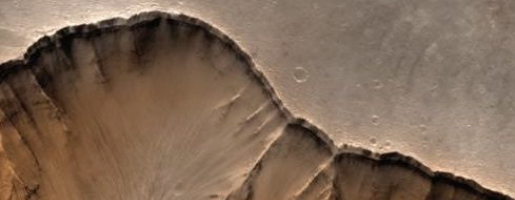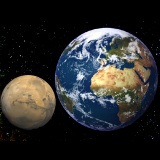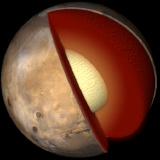 |
||
|
The
layered structure of the canyon walls is a clue to the history of Mars.
|
||
| THE EVOLUTION OF MARS | ||
| Mars is half the size of the Earth and twice as big as the Moon. Slightly denser though than the Moon, it has a lower density than any of the other rocky planets (3930 kg m-3). The interior is inferred to have a lower iron and nickel content than the Earth, but is probably richer in light materials like sulphides and oxygen. | ||
 Comparison between the Earth and Mars. |
||
| The low density of Mars is a result of it forming at a distance from the Sun where relatively light elements were concentrated. The denser materials, concentrated by the effect of gravity nearer the Sun, formed Mercury, Earth and Venus. Initially small grains, then larger bodies, collided and combined with each other in a process known as accretion. That which became Mars grew in size and was able to incorporate yet further Solar System material by its gravitational pull. | ||
| The shape of Mars and the distribution of mass within the planet indicates that it has not evolved as a perfect sphere. The distribution of mass is known to be off-centre because the gravitational field of Mars does not coincide with the physical centre of the planet. | ||
| Though materials are not equally distributed within the planet, it is accepted that Mars is layered or "differentiated". Mars has a core with a radius of 1700 kilometres, a mantle, and a crust reckoned to be about 200 kilometres thick. Little more is known about the interior structure of Mars. The Viking Lander analysis of the surface materials are not thought to provide a good indication of the interior rocks. | ||
 The interior of Mars. |
||
| The accretion of Mars and the segregation of its mass into a layered planet is estimated to have taken about a thousand million years, finishing about 3.6 thousand million years ago. This was followed by the continued heating of the interior by the decay of radioactive elements. Mars expanded and degassing, the escape of volatile materials (gases) from the rocks, occurred. Volcanism and channel formation was also happening between 1.6 to 2.6 thousand million years ago. Since then Mars has cooled and contracted, with volcanic and tectonic (earth movement) activity going on, but more infrequently. | ||
| The northern and southern hemispheres of Mars look very different, this difference may point to some crucial event in the evolution of Mars. The southern hemisphere is dominated by heavily cratered terrain. The density of craters is considered to indicate that the surface survives from the end of the great meteorite bombardment, early in the history of the Solar System. | ||
| The northern hemisphere is dominated by flat and featureless plains and appears to have been resurfaced. But how? There are several ideas. One school of thought proposes that there was a catastrophic collision with a large asteroid four thousand million years ago, soon after the formation of the planet. Others support a purely volcanic origin. Plains volcanism has been widespread on Mars, the products of which are estimated to cover 60% of the Martian surface. The northern hemisphere alone though, is reckoned to comprise 80% volcanic plains. | ||
| All the evidence, the large volcanoes and disruption of the surface, indicate that Mars has been geologically quite active. One of the biggest questions still to answer, is whether or not Mars is active today? Without witnessing a volcanic eruption or recording a "marsquake" it is not possible to be sure. If eruptions were common there might be some sign in the Orbiter images that they've occurred recently. | ||
| Mars may have had a mobile crust and plate tectonics in the past, but it does not appear to have been recycled as is the case on Earth. Rapid cooling would have meant that volcanism and plate movement also declined rapidly. Thickening of the crust, as it cooled, would have made it more difficult for molten rock to reach the surface. Cooling would also have caused the surface to shrink closing volcanic vents and bringing volcanism on Mars to an end. | ||
|
|
||